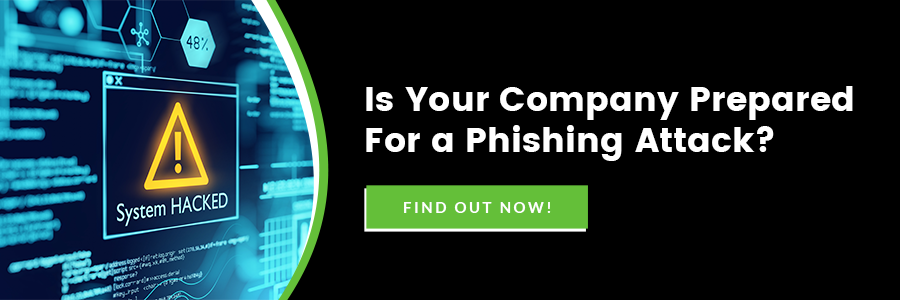Phishing attacks are an ever-present cyber threat for businesses of all sizes and industries. According to data cited by Small Business Trends, “1 in every 99 emails is a phishing attack. And this amounts to 4.8 emails per employee in a five-day work week. Considering close to a third or 30% [of] phishing emails make it past default security, the threat is very much present.”
It only takes one careless click by an employee in your organization for a phishing email attack to work. Despite the risk, many organizations don’t have a plan for how to stop phishing attacks. This is where phishing simulation services can prove to be invaluable.
But first, let's back up and look at the whole picture. What is phishing? What is a phishing simulation? How can phishing email tests help protect your company from phishing attacks? Let’s start with a quick explanation of phishing and the risks posed by this type of cyberattack.
What Is Phishing?
Phishing is a type of “social attack strategy” where the attacker sends fraudulent communications to someone to trick them into taking an action such as clicking on a malware link, surrendering sensitive info, or approving a phony invoice.
There are many types of phishing attacks, and they can be delivered via different communication channels such as emails, text messages, voicemails, and social media messages. Some phishing attack examples include:
- Phishing Emails/Spam. These are the most commonly-encountered phishing attacks, where the phisher sends out hundreds of thousands, or even millions, of spam emails laden with malware to random people.
- Spear Phishing. This is a more targeted type of phishing attack that targets specific people. Instead of sending out a generic mass email, the phisher does research and sends their phishing emails/texts/calls to specific people within an organization. These targeted attacks can be highly successful as they can fool recipients into thinking the phish is a legitimate communication.
- Voice Phishing (Vishing). This is when scammers make phone calls to people. These “vishers” pose as bank employees, tech support, or vendors to trick people into giving up banking details or user account logins.
- Domain Spoofing. A modification of a phishing email, domain spoofing emails make it look like the message is coming from a legitimate source. The attacker changes the domain name of their email (e.g.: changing “John_Smith@hackyou.com” to “John_Smith@ABCSupplies.com”) to get past spam filters that use “blacklists” of known bad domains to stop phishing attempts.
These are just a few of the phishing strategies that you may encounter. To learn more about phishing, check out the phishing page by KnowBe4!
What many phishing attack strategies rely on is the ignorance or lack of caution from the people who receive these bogus communications. Strong cybersecurity awareness and heightened caution towards unsolicited communications can help prevent phishing attacks from succeeding.
This is where phishing simulation services can help!
What Is a Phishing Simulation?
A phishing simulation is a service offered by some managed security service providers (MSSPs). The service provider either uses a software program to create fake phishing messages or makes them manually based on real-world examples.
Simulated phishing attacks are used to test your organization’s employees—seeing who can or cannot recognize a fake message sent by a malicious actor. Employees who fail the phishing test can be sent a message letting them know that they fell for a phishing attempt. You can also arrange additional cybersecurity education and awareness training for employees who fall for the phishing email test.
How Do Phishing Tests Increase My Cybersecurity?
Phishing attacks target the weakest link in any cybersecurity chain: the people who use your IT assets. By tricking your network’s users into downloading malware, giving away login details, or banking/payment info, phishers can commit all kinds of fraud with ease.
Simulated phishing email tests can help strengthen your cybersecurity by:
- Increasing Cybersecurity Awareness. Phishing tests provide your employees with the crucial reminder that they need to remain vigilant against real attacks. If employees know that they may be presented with a test phishing email or message at any time, they’re more likely to closely scrutinize the messages they receive—helping them to spot phishing attacks and avoid them.
- Identifying Specific Phishing Risks. Are there some employees who really need extra training to avoid phishing attacks? Do certain phishing strategies work well on your people? With simulated phishing attacks, you can identify specific vulnerabilities and provide extra cybersecurity awareness training to the people who need it—and customize that training to provide the best possible return on investment!
- Demonstrating Your Return on Mitigation (ROM). One major challenge in any cybersecurity initiative is demonstrating that your security investments are providing a meaningful return. Being able to show how your cybersecurity program is reducing your cybersecurity risks (such as by reducing the chances of phishing emails working on your employees) can help you establish a dollar value for the damage prevented—something the ideaBOX team refers to as your “Return on Mitigation (ROM).” Consider this: A Ponemon study sponsored by IBM reports that the average cost of a data breach is about four million dollars. So, if you spend $50K to stop even one breach, your cybersecurity investment will have paid for itself nearly 80 times over!
Is your organization protected against phishing attacks? Make sure by using ideaBOX’s simulated phishing service now!






